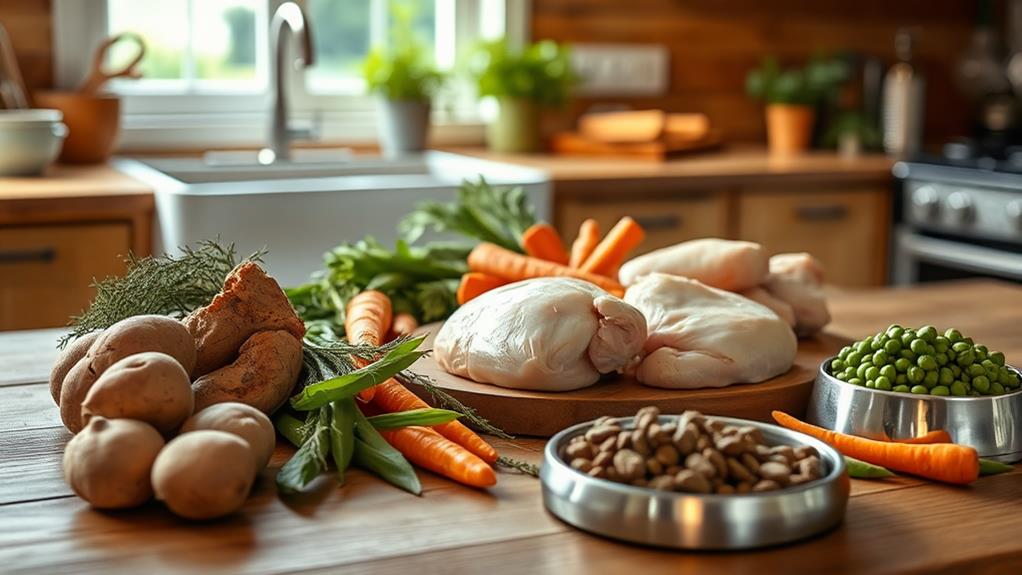If your dog has a sensitive stomach, homemade food can really help. Focus on easy-to-digest ingredients like cooked chicken, rice, and steamed carrots. A simple recipe includes one cup of shredded chicken, one cup of rice, and some low-sodium chicken broth. You might also try mixing ground turkey with canned pumpkin and carrots for added fiber. Avoid fatty meats, dairy, and any common allergens like wheat and corn. Gradually introduce these meals to avoid upset, and always consult your vet for nutritional balance. There's so much more you can explore to guarantee your furry friend feels their best!
Understanding Sensitive Stomachs
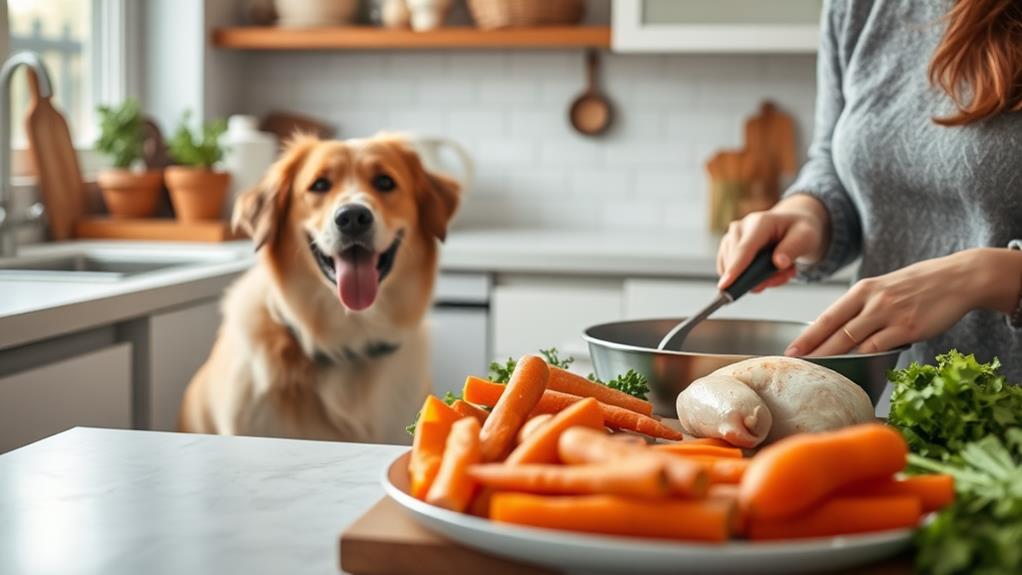
Understanding your dog's sensitive stomach is paramount for their health and well-being. A sensitive stomach can lead to discomfort, vomiting, diarrhea, and other digestive issues. You might notice your dog exhibiting signs of distress after eating certain foods, which can indicate that their digestive system is struggling.
Common causes of a sensitive stomach include food allergies, intolerances, or even abrupt changes in diet. If your dog's diet suddenly shifts, they might react negatively to new ingredients. It's essential to identify what foods trigger these sensitivities and avoid them altogether.
You should also pay attention to your dog's eating habits. Eating too quickly can cause digestive upset, so consider using slow-feeders or puzzle bowls to help. Additionally, stress can contribute to gastrointestinal issues, so maintaining a calm environment can aid in their overall digestion.
Regular vet check-ups are necessary, especially if your dog frequently experiences stomach issues. Your vet can help identify any underlying conditions and suggest a suitable diet. By understanding your dog's sensitive stomach, you can make informed choices that promote their health and happiness.
Key Ingredients to Include
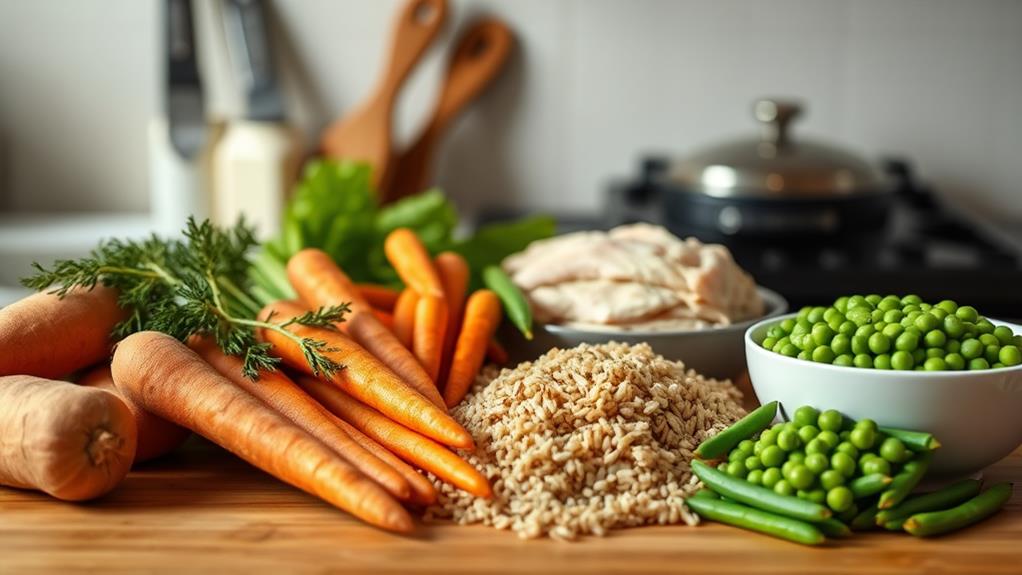
When creating homemade dog food for a sensitive stomach, it's crucial to include ingredients that are gentle on digestion. By selecting the right components, you can help alleviate discomfort while ensuring your furry friend gets the nutrition they need.
Lean Proteins: Chicken or turkey is easy on the stomach and provides essential amino acids.
Cooked Rice or Quinoa: These grains are simple to digest and serve as a great carbohydrate source.
Sweet Potatoes: Packed with vitamins and fiber, sweet potatoes can help soothe digestive issues.
Pumpkin: This nutrient-rich option aids in digestion and can help regulate bowel movements.
Ingredients to Avoid
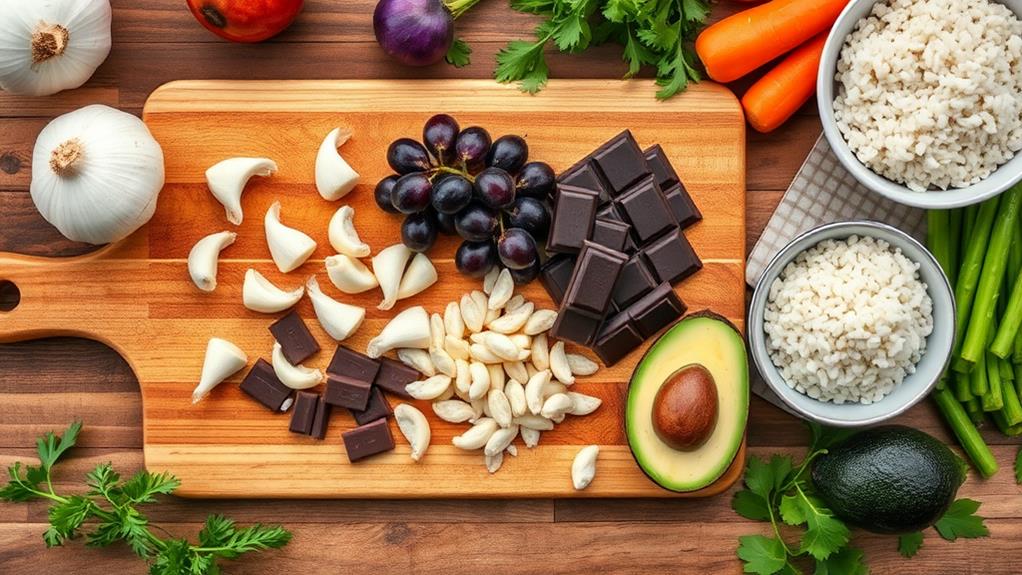
Even with the right ingredients, some foods can still upset your dog's sensitive stomach. It's essential to know which ingredients to avoid when preparing homemade dog food.
First off, stay away from fatty cuts of meat, as high fat content can lead to digestive issues. Also, avoid common allergens like wheat, corn, and soy, which might cause discomfort or allergic reactions.
Dairy products are another ingredient to skip, since many dogs are lactose intolerant and can suffer from gas or diarrhea. Keep chocolate, caffeine, and alcohol far from your pup's meals, as these are toxic to dogs and can lead to severe health problems.
Onions and garlic should be off-limits too; both can damage red blood cells and cause anemia. Ultimately, avoid any processed foods or those high in preservatives, as they can upset your dog's stomach and lead to long-term health issues.
Simple Chicken and Rice Recipe
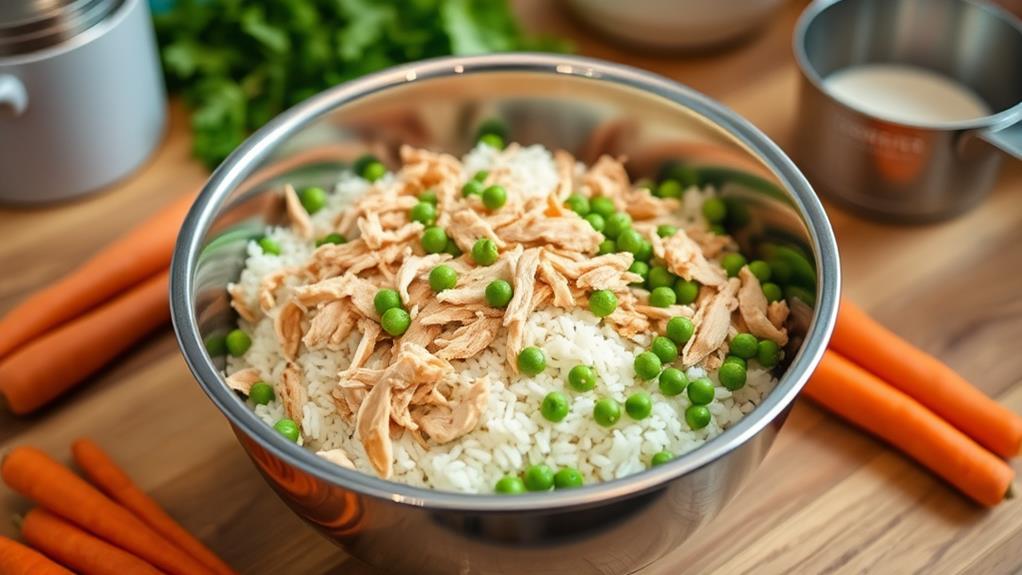
[TEXT]:
For a quick and easy meal that's gentle on your dog's stomach, try this Simple Chicken and Rice recipe. This dish combines lean protein and easily digestible carbohydrates, making it perfect for dogs with sensitive stomachs.
Here's what you'll need to prepare this nutritious meal:
- 1 cup of cooked, shredded chicken: Use skinless, boneless chicken for a lean option.
- 1 cup of white rice: Opt for plain white rice, as it's gentle on digestion.
- 2 cups of low-sodium chicken broth: This adds flavor and hydration without extra salt.
- 1 cup of steamed carrots: Chopped into small pieces, carrots provide vitamins and fiber.
To make the meal, simply cook the chicken in the broth until it's tender, then shred it. Cook the rice separately according to package instructions, adding the carrots in the last few minutes. Finally, mix everything together, and you're ready to serve!
Your dog will love the taste, and you'll appreciate how easy it's to make. This Simple Chicken and Rice recipe isn't only comforting but also a great way to help your furry friend feel their best!
Pumpkin and Turkey Mix
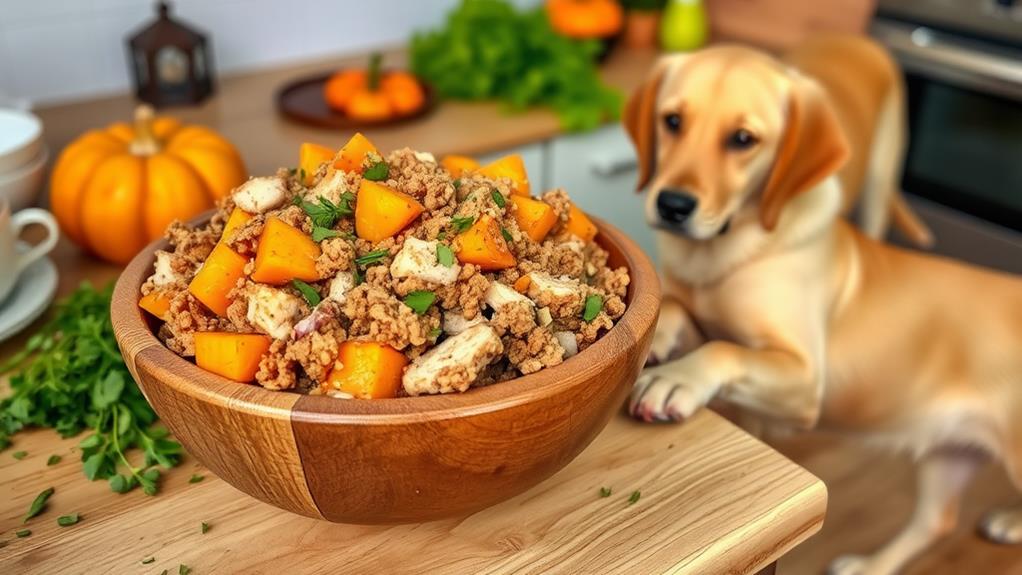
If you're looking for a nutritious option that supports your dog's digestive health, the Pumpkin and Turkey Mix is an excellent choice. This recipe combines lean turkey with the natural fiber of pumpkin, making it gentle on your pup's stomach while still being delicious. Plus, it's easy to prepare!
Here's a simple breakdown of the ingredients and their benefits:
| Ingredient | Benefits |
|---|---|
| Ground Turkey | High in protein, promotes muscle health |
| Canned Pumpkin | Rich in fiber, aids digestion |
| Carrots | Provides vitamins, supports vision |
| Olive Oil | Healthy fats, promotes a shiny coat |
To make this mix, cook the ground turkey in a skillet until browned. Add in canned pumpkin and finely chopped carrots, stirring until everything is well combined. Drizzle a little olive oil for added flavor and nutrition. Let it cool before serving it to your dog.
This Pumpkin and Turkey Mix not only supports your dog's digestive health but also provides essential nutrients they need to thrive. Give it a try, and watch your furry friend enjoy every bite!
Sweet Potato and Fish Dish

After exploring the benefits of the Pumpkin and Turkey Mix, you'll find that the Sweet Potato and Fish Dish offers another fantastic option for dogs with sensitive stomachs. This dish combines nutritious ingredients that are gentle on your pup's tummy while providing essential nutrients. Sweet potatoes are rich in fiber, vitamins, and minerals, making them a great choice for digestive health. Fish, like salmon or whitefish, offers high-quality protein and omega-3 fatty acids, which can promote healthy skin and coat.
When preparing this dish, imagine the delightful blend of colors and textures that will make your dog's meal special:
- Vibrant orange sweet potatoes, mashed to creamy perfection
- Flaky, tender fish, cooked to retain its moisture
- A sprinkle of fresh parsley for a touch of flavor
- A drizzle of olive oil to enhance the dish's richness
This Sweet Potato and Fish Dish not only satisfies your dog's taste buds but also provides a well-balanced meal that supports overall health. Your furry friend will love this nutritious option, and you'll feel good knowing you're helping their sensitive stomach!
Tips for Serving Homemade Food
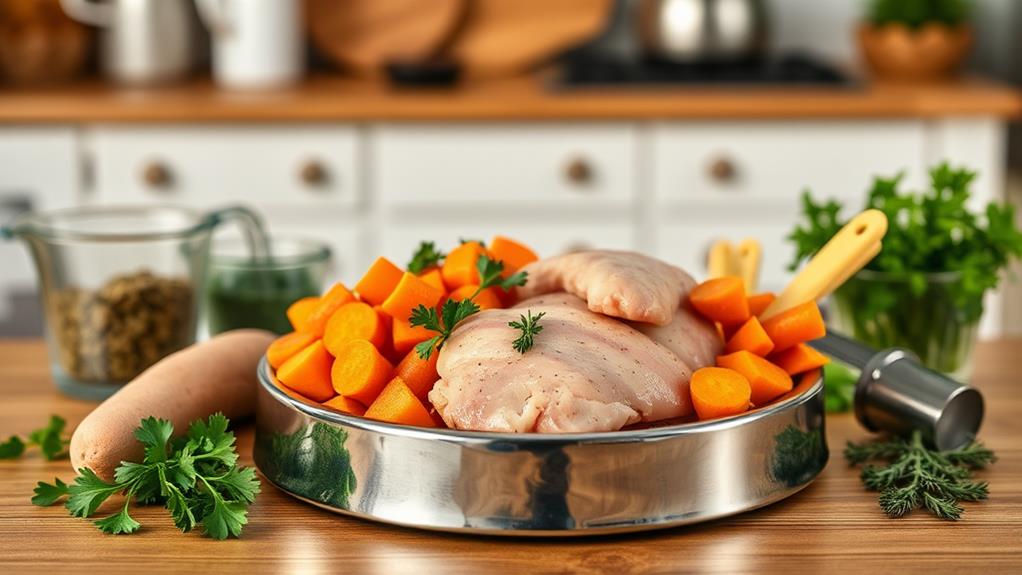
Serving homemade food to your dog can be a rewarding experience, but it's essential to approach it with care and consideration. Start by ensuring you've balanced the nutritional needs of your dog. Consult with a vet to confirm that your recipes include all essential nutrients like proteins, fats, vitamins, and minerals.
When serving, gradually introduce homemade meals into your dog's diet. This helps avoid digestive upset. Begin with a small portion mixed with their regular food, increasing the homemade portion over several days. Monitor your dog for any adverse reactions, like vomiting or diarrhea, and adjust accordingly.
Portion control is key. Measure your dog's food based on their weight, age, and activity level to prevent overfeeding. Consider dividing their daily intake into two or three meals to maintain energy levels throughout the day.
Always serve food at room temperature; this guarantees it's palatable and doesn't shock your dog's system. Finally, store leftovers properly in airtight containers and refrigerate them. Remember to discard any food left out for more than two hours to avoid spoilage. By taking these steps, you'll create a safe and enjoyable homemade dining experience for your furry friend.
Frequently Asked Questions
Can I Mix Homemade Food With Commercial Dog Food?
Yes, you can mix homemade food with commercial dog food. Just guarantee the combination meets your dog's nutritional needs and monitor their reaction. Gradually introduce the mix to avoid digestive upset or adverse reactions.
How Often Should I Change My Dog's Homemade Recipes?
Studies show 60% of dogs thrive on varied diets. You should change your dog's homemade recipes every few weeks to prevent boredom and guarantee balanced nutrition. Keep an eye on their reactions to new ingredients!
Is It Safe to Add Supplements to Homemade Dog Food?
It's generally safe to add supplements to your dog's food, but you should consult your vet first. They can recommend the right supplements and dosages, ensuring your dog gets balanced nutrition without any adverse effects.
How Do I Know if My Dog Is Allergic to an Ingredient?
To determine if your dog's allergic to an ingredient, watch for symptoms like itching, digestive upset, or ear infections after eating. Keep a food diary to track reactions and consult your vet for guidance.
Can I Freeze Homemade Dog Food for Later Use?
Yes, you can freeze homemade dog food for later use. Just portion it out in airtight containers or freezer bags. When you're ready, thaw it in the fridge and serve. It stays fresh longer!
Conclusion
Making homemade dog food for sensitive stomachs is a great way to guarantee your furry friend gets the nutrition they need without unwanted ingredients. Think of it like crafting a cozy blanket, weaving together just the right threads for comfort and support. By selecting the right ingredients and avoiding harmful ones, you can whip up meals that keep their tummy happy. Remember, every pup is unique, so keep an eye on how they respond to their new diet!

